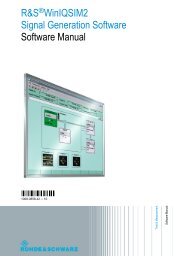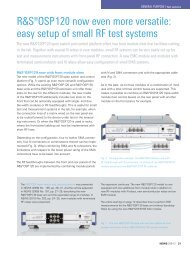News from Rohde&Schwarz - Rohde & Schwarz
News from Rohde&Schwarz - Rohde & Schwarz
News from Rohde&Schwarz - Rohde & Schwarz
You also want an ePaper? Increase the reach of your titles
YUMPU automatically turns print PDFs into web optimized ePapers that Google loves.
Application notes<br />
Photo 43 172/2<br />
Monitoring DAB and DVB-T transmitter systems<br />
Measurements made easy:<br />
firm grip on complex problems<br />
To identify transmitters, handle interference and verify compliance with stipulated<br />
conditions for authorization, the monitoring services of licensing authorities must<br />
be capable of measuring the technical parameters of transmitter systems off air.<br />
<strong>Rohde</strong> & <strong>Schwarz</strong> offers an extensive range of monitoring and measuring equipment<br />
for this purpose (FIG 1).<br />
FIG 1 <strong>Rohde</strong> & <strong>Schwarz</strong> offers an extensive<br />
range of stationary and mobile monitoring and<br />
measuring equipment for the latest methods of<br />
digital transmission<br />
Evaluation of interference on digital<br />
transmission links additionally requires<br />
measurements of coverage and bit<br />
error rate. Here too, <strong>Rohde</strong> & <strong>Schwarz</strong><br />
is able to offer a wide selection of coverage<br />
measurement systems [2].<br />
Typical tasks of monitoring<br />
services<br />
Receive level<br />
The strength of the receive level must<br />
be known to assess quality and propagation<br />
conditions. And it is also the<br />
basis for coverage measurements.<br />
Unlike with analog signals, the type<br />
of detector used plays an important<br />
role in transmissions with digital contents.<br />
Depending on the modulation<br />
of the individual carriers, the level of<br />
a DAB/DVB-T signal has different<br />
peak, average and rms values.<br />
Whereas the peak value of the main<br />
carrier (or the sum of the carriers with<br />
COFDM) represents the maximum of<br />
the rms values collected during the<br />
measurement time, the time-averaged<br />
rms value corresponds to the power<br />
of an unmodulated CW carrier of the<br />
same level. Both values can be varied<br />
by suitably influencing (coding) the<br />
transmitted information. For example,<br />
if you ensure that practically no<br />
64QAM values simultaneously have 0°<br />
or 180° phase and maximum amplitude,<br />
the result is a signal with a very<br />
large margin between peak and rms,<br />
whereas in simple frequency shift key-<br />
Complete product line for<br />
complex measurement tasks<br />
Modern DAB and DVB-T systems use<br />
complex modes of digital transmission,<br />
the measurement and identification of<br />
which require special instruments and<br />
methods. All major technical parameters<br />
of such systems can be measured<br />
with Spectrum Monitoring System<br />
ARGUS-IT (formerly SMSI) [1] together<br />
with Spectrum Analyzer FSE, Signal<br />
Analyzer FSIQ or EMI Test Receiver<br />
ESI plus Measurement Software<br />
ArgusMon (FIG 2). Some typical measurements<br />
are described below.<br />
FIG 2<br />
Dialog window of EMI Test Receiver ESI in<br />
DAB/DVB-T measurements with Measurement<br />
Software ArgusMon<br />
<strong>News</strong> <strong>from</strong> <strong>Rohde</strong> & <strong>Schwarz</strong> Number 164 (1999/IV) 17

















